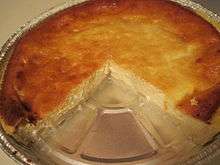Flan
 | |
| Course | Main course or Dessert or Snack |
|---|---|
| Serving temperature | Cold |
| Main ingredients | pastry, custard (sweet flans), vegetables (savoury flans) |
A flan, in English and other cuisines, is a dish with an open, rimmed pastry or sponge base containing a sweet or savoury filling. Examples are the quiche lorraine, custard tart, leche flan, and the South African melktert.
History
Flan is known in Roman cuisine. It was often a savory dish, as in "eel flan"; sweet flans, made with honey and pepper, were also enjoyed.
In the Middle Ages, both sweet and savory flans (almonds, cinnamon & sugar; cheese, curd, spinach, fish) were very popular in Europe, especially during Lent, when meat was forbidden.[1]
Etymology
The English word "flan", and the earlier forms "flaune" and "flawn", come from the Old French flaon (modern French flan), in turn from the early Medieval Latin fladōn-em, derived from the Old High German flado, a sort of flat cake, probably from an Indo-European root for "flat" or "broad".[2]
See also
References
- ↑ Olver, Lynne. "history notes - puddings". Foodtimeline. Archived from the original on 9 May 2018. Retrieved 9 May 2018.
- ↑ Oxford English Dictionary, 2nd Edition (1989); Petit Robert 1973.